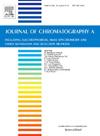Direct ion chromatographic method for speciation micro analysis of arsenic forms in industrial samples with “rich” matrix composition
IF 3.8
2区 化学
Q1 BIOCHEMICAL RESEARCH METHODS
引用次数: 0
Abstract
The speciation analysis of arsenic has consistently been a subject of great interest. However, it remains challenging to analyze complex matrix samples that contain both arsenic and interfering components. In this case, it can be hard to choose the right combinations of different instrumental methods, or a separation method followed by detection, which is usually done using a spectral approach (hybrid methods). In the production control of copper electrorefining, the determination of the concentration of As (III) and As (V) helps to improve the quality of the cathode copper produced. This work investigated the possibility of directly determining both arsenic forms and total As in an electrolyte bath using ion chromatography (IC) with conductometric detection. The use of the ion chromatographic approach for the determination of As(V) in complex matrix samples such as copper electrolyte must take into account the presence of potential interferences from anions such as sulphates, sulfites, selenites, selenates, etc. The results revealed that the method is accurate and precise, with As(V) quantification limits of 15 µg.L-1 and detection limits of 5 µg.L-1. This method is suitable for assessing various types of arsenic in the production of electrolytic copper, with the aim of replacing the current technique that requires liquid-liquid extraction and ICP-OES detection. This led to the following improvements: Enhanced efficiency: The method eliminates the need for extensive and time-consuming sample preparation for the initial separation of arsenic forms. At the same time, the method's characteristics are comparable to those of ICP-OES with liquid-liquid extraction, which is often used in the speciation analysis of arsenic. The method is environmentally friendly as it avoids the use of organic and poisonous extractants. The method can simultaneously analyze other anions (PO43-, SO42-, F-, Cl-, etc.) with arsenates with appropriate calibration.
采用直接离子色谱法对基质成分 "丰富 "的工业样品中的砷形态进行微量标本分析。
砷的标样分析一直是备受关注的课题。然而,对同时含有砷和干扰成分的复杂基质样品进行分析仍然具有挑战性。在这种情况下,很难选择不同仪器方法的正确组合,或者选择先分离后检测的方法(通常使用光谱方法(混合方法))。在电解铜的生产控制中,测定 As (III) 和 As (V) 的浓度有助于提高所生产阴极铜的质量。这项工作研究了利用离子色谱法(IC)和电导检测法直接测定电解液中砷形式和总砷的可能性。使用离子色谱法测定铜电解液等复杂基质样品中的 As(V),必须考虑到硫酸盐、亚硫酸盐、亚硒酸盐、硒酸盐等阴离子的潜在干扰。结果表明,该方法准确、精确,As(V)的定量限为 15 µg.L-1,检出限为 5 µg.L-1。该方法适用于评估电解铜生产中的各类砷,旨在取代目前需要液液萃取和 ICP-OES 检测的技术。这带来了以下改进:提高效率:该方法无需进行大量耗时的样品制备来初步分离砷形态。同时,该方法的特性可与常用于砷标样分析的液液萃取 ICP-OES 方法相媲美。该方法避免了有机和有毒萃取剂的使用,因此非常环保。通过适当的校准,该方法可同时分析砷酸盐和其他阴离子(PO43-、SO42-、F-、Cl- 等)。
本文章由计算机程序翻译,如有差异,请以英文原文为准。
求助全文
约1分钟内获得全文
求助全文
来源期刊

Journal of Chromatography A
化学-分析化学
CiteScore
7.90
自引率
14.60%
发文量
742
审稿时长
45 days
期刊介绍:
The Journal of Chromatography A provides a forum for the publication of original research and critical reviews on all aspects of fundamental and applied separation science. The scope of the journal includes chromatography and related techniques, electromigration techniques (e.g. electrophoresis, electrochromatography), hyphenated and other multi-dimensional techniques, sample preparation, and detection methods such as mass spectrometry. Contributions consist mainly of research papers dealing with the theory of separation methods, instrumental developments and analytical and preparative applications of general interest.
 求助内容:
求助内容: 应助结果提醒方式:
应助结果提醒方式:


